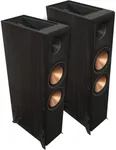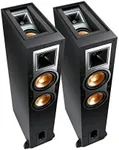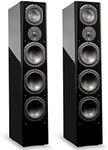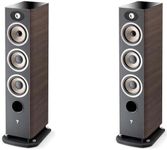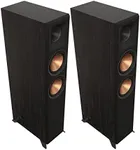Buying Guide for the Best Floor Standing Speakers
Choosing the right floor-standing speakers can significantly enhance your audio experience, whether you're setting up a home theater or simply enjoying music. The key is to understand the various specifications and how they align with your needs and preferences. By focusing on the right specs, you can ensure that you get the best sound quality and performance for your space.Frequency ResponseFrequency response refers to the range of frequencies a speaker can reproduce, typically measured in Hertz (Hz). This spec is important because it determines how well the speaker can handle different types of sounds, from deep bass to high treble. A wider frequency range means the speaker can produce a more complete and accurate sound. For general listening, a range of 20Hz to 20kHz is ideal, as it covers the full spectrum of human hearing. If you enjoy bass-heavy music or movies, look for speakers with a lower minimum frequency.
SensitivitySensitivity measures how efficiently a speaker converts power into sound, usually expressed in decibels (dB). This spec is crucial because it affects how loud the speaker can get with a given amount of power. Higher sensitivity (above 90 dB) means the speaker can produce more volume with less power, making it suitable for larger rooms or less powerful amplifiers. Lower sensitivity (below 88 dB) might require more powerful amplification but can still deliver excellent sound quality in smaller spaces.
ImpedanceImpedance is the resistance a speaker offers to the electrical current from an amplifier, measured in ohms. This spec is important because it affects the compatibility between the speaker and your amplifier or receiver. Most floor-standing speakers have an impedance of 4, 6, or 8 ohms. Ensure that your amplifier can handle the speaker's impedance to avoid damaging either component. For most home audio systems, 8-ohm speakers are a safe and versatile choice.
Power HandlingPower handling indicates the amount of power a speaker can handle without distortion or damage, measured in watts. This spec is important for matching the speaker with your amplifier's power output. There are two values to consider: RMS (continuous power) and peak power. RMS is the amount of power the speaker can handle continuously, while peak power is the maximum it can handle in short bursts. Choose speakers with an RMS rating that matches or slightly exceeds your amplifier's output for optimal performance.
Driver ConfigurationDriver configuration refers to the arrangement and types of drivers (woofers, midrange, and tweeters) in the speaker. This spec is important because it affects the speaker's ability to reproduce different frequencies accurately. A typical floor-standing speaker may have multiple drivers to handle various parts of the audio spectrum. For example, a three-way speaker with separate drivers for bass, midrange, and treble can provide a more balanced and detailed sound. Consider your listening preferences and the type of content you enjoy to choose the right driver configuration.
Cabinet DesignCabinet design encompasses the materials and construction of the speaker enclosure. This spec is important because it influences the speaker's sound quality and durability. Well-designed cabinets reduce unwanted vibrations and resonance, resulting in clearer sound. Look for cabinets made from high-quality materials like MDF (medium-density fiberboard) or solid wood, and consider features like internal bracing and damping. The design should also complement your room's aesthetics and fit comfortably in your space.
Size and PlacementSize and placement refer to the physical dimensions of the speakers and where you plan to position them in your room. This spec is important because it affects both the sound quality and the overall look of your setup. Larger speakers generally produce more powerful sound but require more space. Ensure you have enough room to place the speakers at an optimal distance from walls and other objects to avoid sound reflections and achieve the best audio performance. Consider your room size and layout when choosing the right size and placement for your speakers.




